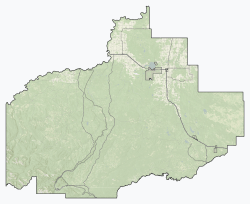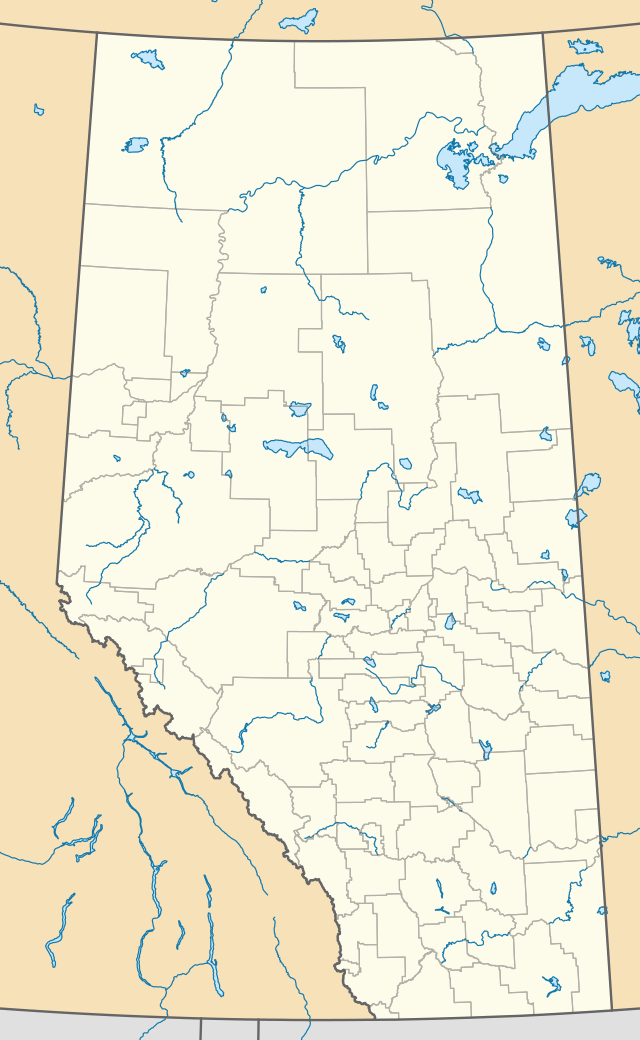Grande Cache
Grande Cache is a hamlet within and administered by the Municipal District of Greenview No. 16 in west-central Alberta, Canada. It is located on Highway 40 approximately 145 kilometres (90 mi) northwest of Hinton and 435 kilometres (270 mi) west of Edmonton. Grande Cache overlooks the Smoky River, is at the northern edge of Alberta's Rockies, and serves as the gateway to the Willmore Wilderness Park. The hamlet held town status prior to 2019.
Grande Cache | |
|---|---|
Hamlet | |
Highway 40 through Grande Cache | |
 Grande Cache Location in M.D. of Greenview  Grande Cache Location in Alberta | |
| Coordinates: 53°53′19″N 119°07′06″W | |
| Country | Canada |
| Province | Alberta |
| Region | Northern Alberta |
| Planning region | Upper Peace |
| Municipal district | Greenview |
| Incorporated[1][2] | |
| • New town | September 1, 1966 |
| • Town | September 1, 1983 |
| Dissolved (Hamlet) | January 1, 2019 |
| Government | |
| • Governing body | Municipal District of Greenview No. 16 Council |
| • MP | Jim Eglinski (Cons - Yellowhead) |
| • MLAs | Martin Long (UCP - West Yellowhead) |
| Area (2016)[3] | |
| • Land | 34.97 km2 (13.50 sq mi) |
| Elevation | 1,220 m (4,000 ft) |
| Population (2016)[3] | |
| • Total | 3,571 |
| • Density | 102.1/km2 (264/sq mi) |
| Time zone | UTC−7 (MST) |
| • Summer (DST) | UTC−6 (MDT) |
| Postal code | T0E 0Y0 |
| Area code(s) | +1-780 |
| Website | Official website |
History
The New Town of Grande Cache was incorporated on September 1, 1966.[1] The purpose of creating a new town was to open the area for the development of coal mines. New town status allowed the town to use the Government of Alberta as a guarantor for debt.
Construction of Grande Cache began in 1969. By 1971 a hospital, schools, stores, and the first homes were built.
Grande Cache received town status on September 1, 1983.[1]
The community suffered a boom-bust cycle due to the dependence on a single employer that depended on a single commodity: coal. In an attempt to diversify the economy additional industries were encouraged to develop in the area. This included a wood chip plant and a federal prison operated by the Correctional Service of Canada. In recent years, wilderness tourism is an increasing industry.
In September 2018, Grande Cache's Town Council determined that, due to a reduction in population and the subsequent loss in tax revenue, the town was no longer financially sustainable.[5] On September 25, 2018, town residents voted to dissolve the town into a hamlet under the jurisdiction of the Municipal District (MD) of Greenview No. 16.[6] Out of 1,100 ballots cast in the vote, 1,065 were votes in favour of dissolution, 32 were in favour of remaining a town, and 3 ballots were rejected.[6] The dissolution came into effect on January 1, 2019, rendering Grande Cache a hamlet in the Municipal District of Greenview No. 16.[2]
Geography
The town is built on a plateau that is just below the subalpine level of the Rocky Mountains. The town site is surrounded by three valleys: to the north is the Smoky River; to the west is the Sulphur River; to the south is Victor Lake and Grande Cache Lake. To the east of town is Grande Mountain.
Climate
Grande Cache experiences a subarctic climate (Köppen climate classification Dfc). Summertime is usually very mild, but can also be very cool or warm depending on the movement of different airmasses in the area. Wintertime is very cold and snowy, lasting from November into March, and sometimes even later.
| Climate data for Grande Cache | |||||||||||||
|---|---|---|---|---|---|---|---|---|---|---|---|---|---|
| Month | Jan | Feb | Mar | Apr | May | Jun | Jul | Aug | Sep | Oct | Nov | Dec | Year |
| Record high °C (°F) | 14 (57) |
16 (61) |
18 (64) |
25 (77) |
29.5 (85.1) |
30 (86) |
31 (88) |
31 (88) |
32 (90) |
24 (75) |
18 (64) |
16 (61) |
32 (90) |
| Average high °C (°F) | −2.2 (28.0) |
−1 (30) |
2.6 (36.7) |
8.5 (47.3) |
13.3 (55.9) |
17.1 (62.8) |
19.6 (67.3) |
19 (66) |
14.7 (58.5) |
9 (48) |
0.6 (33.1) |
−2.5 (27.5) |
8.2 (46.8) |
| Daily mean °C (°F) | −7.1 (19.2) |
−6.5 (20.3) |
−2.9 (26.8) |
2.7 (36.9) |
7.3 (45.1) |
11.1 (52.0) |
13.3 (55.9) |
12.7 (54.9) |
8.9 (48.0) |
4 (39) |
−4.2 (24.4) |
−7.5 (18.5) |
2.7 (36.9) |
| Average low °C (°F) | −12.1 (10.2) |
−11.9 (10.6) |
−8.4 (16.9) |
−3.2 (26.2) |
1.4 (34.5) |
5 (41) |
7 (45) |
6.4 (43.5) |
3.1 (37.6) |
−1.1 (30.0) |
−8.9 (16.0) |
−12.5 (9.5) |
−2.9 (26.8) |
| Record low °C (°F) | −39 (−38) |
−41 (−42) |
−37.8 (−36.0) |
−22 (−8) |
−12 (10) |
−3.9 (25.0) |
0.5 (32.9) |
−5 (23) |
−10 (14) |
−30 (−22) |
−43 (−45) |
−41 (−42) |
−43 (−45) |
| Average precipitation mm (inches) | 24.9 (0.98) |
26.6 (1.05) |
30.5 (1.20) |
25.6 (1.01) |
57.8 (2.28) |
69 (2.7) |
83.2 (3.28) |
70.1 (2.76) |
52.5 (2.07) |
34.3 (1.35) |
33.6 (1.32) |
31.5 (1.24) |
539.6 (21.24) |
| Source: Environment Canada[7] | |||||||||||||
Demographics
| Year | Pop. | ±% |
|---|---|---|
| 1971 | 2,525 | — |
| 1976 | 4,116 | +63.0% |
| 1981 | 4,523 | +9.9% |
| 1986 | 3,646 | −19.4% |
| 1991 | 3,842 | +5.4% |
| 1996 | 4,441 | +15.6% |
| 2001 | 3,828 | −13.8% |
| 2006 | 3,783 | −1.2% |
| 2011 | 4,319 | +14.2% |
| 2016 | 3,571 | −17.3% |
| Source: Statistics Canada [8][9][10][11][12][3] | ||
In the 2016 Census of Population conducted by Statistics Canada, Grande Cache recorded a population of 3,571 living in 1,296 of its 1,759 total private dwellings, a -17.3% change from its 2011 population of 4,319. With a land area of 34.97 km2 (13.50 sq mi), it had a population density of 102.1/km2 (264.5/sq mi) in 2016.[3]
In the 2011 Census, Grande Cache had a population of 4,319 living in 1,563 of its 1,752 total dwellings, a 14.2% change from its 2006 population of 3,783. With a land area of 35.48 km2 (13.70 sq mi), it had a population density of 121.7/km2 (315.3/sq mi) in 2011.[13]
Attractions
- Grande Cache Recreation Centre
- Grande Cache Golf and Country Club
- Great Canadian Death Race
- Willmore Wilderness Park
Sports
Grande Cache is the home of the Canadian Death Race.
Infrastructure
Grande Cache is the site of the Grande Cache Institution, a medium-security prison.
Transportation
Grande Cache is connected to Grande Prairie and Hinton via Highway 40. There is a community bus service to Grande Prairie once a week and to Hinton once a month. Grande Cache Airport is 24 km (15 mi) outside of town. There are no scheduled flights into Grande Cache Airport.
Education
Local schools in Grande Cache include:
- Sheldon Coates Elementary School (K-3);
- Summitview School (grades 4-8);
- SonRise Christian School (K-6); and
- Grande Cache Community High School (grades 9-12).
Media
Grande Cache has one weekly paper, the Grande Cache Mountaineer.
Notable people
- Dean McAmmond, professional hockey player
- Travis Roche, professional hockey player
See also
| Wikivoyage has a travel guide for Grande Cache. |
References
- "Location and History Profile: Town of Grande Cache" (PDF). Alberta Municipal Affairs. October 7, 2016. p. 274. Retrieved October 11, 2016.
- "Order in Council (O.C.) 361/2018". Government of Alberta. November 27, 2018. Retrieved January 13, 2019.
- "Population and dwelling counts, for Canada, provinces and territories, and census subdivisions (municipalities), 2016 and 2011 censuses – 100% data (Alberta)". Statistics Canada. February 8, 2017. Retrieved February 8, 2017.
- "Alberta Private Sewage Systems 2009 Standard of Practice Handbook: Appendix A.3 Alberta Design Data (A.3.A. Alberta Climate Design Data by Town)" (PDF) (PDF). Safety Codes Council. January 2012. pp. 212–215 (PDF pages 226–229). Retrieved October 8, 2013.
- "Grande Cache deemed not viable to carry on as a town". Global News. September 19, 2018. Retrieved September 19, 2018.
- "Residents of Grande Cache vote to dissolve town". Global News. September 26, 2018. Retrieved September 26, 2018.
- Environment Canada Canadian Climate Normals 1971–2000, accessed 24 July 2009
- "Table 3: Population for census divisions and subdivisions, 1971 and 1976". 1976 Census of Canada. Census Divisions and Subdivisions, Western Provinces and the Territories. Population: Geographic Distributions. Ottawa: Statistics Canada. 1977.
- "Table 2: Census Subdivisions in Alphabetical Order, Showing Population Rank, Canada, 1981". 1981 Census of Canada. Census subdivisions in decreasing population order. Ottawa: Statistics Canada. 1982. ISBN 0-660-51563-6.
- "Table 2: Population and Dwelling Counts, for Census Divisions and Census Subdivisions, 1986 and 1991 – 100% Data". 91 Census. Population and Dwelling Counts – Census Divisions and Census Subdivisions. Ottawa: Statistics Canada. 1992. pp. 100–108. ISBN 0-660-57115-3.
- "Population and Dwelling Counts, for Canada, Provinces and Territories, and Census Divisions, 2001 and 1996 Censuses – 100% Data (Alberta)". Statistics Canada. Retrieved 2019-05-25.
- "Population and dwelling counts, for Canada, provinces and territories, and census subdivisions (municipalities), 2006 and 2001 censuses – 100% data (Alberta)". Statistics Canada. January 6, 2010. Retrieved 2019-05-25.
- "Population and dwelling counts, for Canada, provinces and territories, and census subdivisions (municipalities), 2011 and 2006 censuses (Alberta)". Statistics Canada. 2012-02-08. Retrieved 2012-02-08.